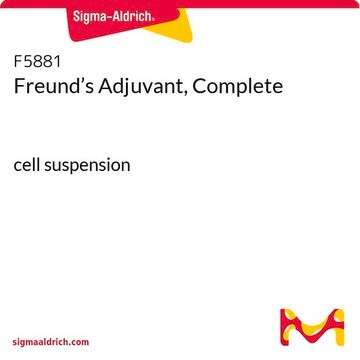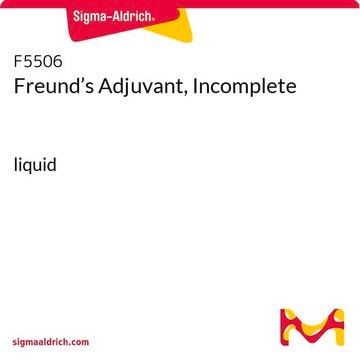Transportation information can be found in Section 14 of the product's (M)SDS.To access the shipping information for this material, use the link on the product detail page for the product.
C9142
Cyanogen bromide-activated-Sepharose™ 4B
lyophilized powder
Synonyme(s) :
Cyanogen bromide-activated Agarose
Sélectionner une taille de conditionnement
101,00 €
Sélectionner une taille de conditionnement
About This Item
101,00 €
Produits recommandés
Forme
lyophilized powder
Technique(s)
affinity chromatography: suitable
Matrice
Sepharose 4B
Groupe de la matrice active
cyanate or related structures
Espaceur de matrice
1 atom (when ligands are coupled via isourea derivative or related linkage)
Gonflement
1 g swells to 4-5 mL
Taille des particules
45—165 μm
Température de stockage
2-8°C
Vous recherchez des produits similaires ? Visite Guide de comparaison des produits
Description générale
C9142-15G′s updated product number is GE17-0430-01
Application
- in the purification of clusterin from serum by an immunoaffinity-based separation procedure
- in affinity chromatography to isolate Leishmania donovani protein antigens from the urine of visceral leishmaniasis patients
- in affinity chromatography for the isolation of haptoglobin from human serum
Forme physique
Informations légales
Produit(s) apparenté(s)
Remplacé(e)(s) par
Code de la classe de stockage
11 - Combustible Solids
Classe de danger pour l'eau (WGK)
WGK 3
Point d'éclair (°F)
Not applicable
Point d'éclair (°C)
Not applicable
Équipement de protection individuelle
Eyeshields, Gloves, type N95 (US)
Faites votre choix parmi les versions les plus récentes :
Certificats d'analyse (COA)
Vous ne trouvez pas la bonne version ?
Si vous avez besoin d'une version particulière, vous pouvez rechercher un certificat spécifique par le numéro de lot.
Déjà en possession de ce produit ?
Retrouvez la documentation relative aux produits que vous avez récemment achetés dans la Bibliothèque de documents.
Les clients ont également consulté
-
What is the Department of Transportation shipping information for this product?
1 answer-
Helpful?
-
-
After I've washed and prepared the resin in Product C9142, Cyanogen bromide-activated-Sepharose®, for the coupling reaction, how long can I wait before coupling the ligand to the resin?
1 answer-
We would recommend coupling the ligand immediately after washing and preparing the resin. This is because the reactive groups hydrolyze in the basic solution conditions of the preparation steps. The solutions used in the coupling reaction should also be kept cold (2-8°C) during the procedure.
Helpful?
-
-
Should I use a desiccator environment for storage of Cyanogen bromide-activated-Sepharose®?
1 answer-
It is a good idea to store the CNBr-activated agarose products in as dry an environment as possible, because the reactive groups are very moisture-sensitive.
Helpful?
-
-
How are proteins attached to the Cyanogen bromide-activated Sepharose® in Product C9142?
1 answer-
Coupling of molecules to CNBr-activated Sepharose® is usually via amine groups. In the case of proteins, this usually means the epsilon amines (exocyclic amines) of lysine groups.
Helpful?
-
-
What kind of volume should I use for my ligand to couple to the Cyanogen bromide-activated Sepharose®, Product C9142?
1 answer-
It is best that the coupling ligand should not be in too dilute a solution. In general, a volume ratio of 0.5 to 1 of coupling solution to CNBr-activated Sepharose® is recommended.
Helpful?
-
-
When using Product C9142, Cyanogen bromide-activated-Sepharose®, is there a particular storage buffer that I should use after I've coupled my ligand to the resin?
1 answer-
This depends on the particular situation, and the answer depends more on the coupled ligand than the resin itself. The most important criterion is to choose a buffer that is not harmful to the ligand. It is common to include 20% ethanol or preservatives like sodium azide or thimerosal (~0.02%) to inhibit potential bacterial growth.
Helpful?
-
-
My ligand is in Tris buffer. Can I use Product C9142, Cyanogen bromide-activated-Sepharose®, with this sample?
1 answer-
Because Tris is an amine-containing buffer, we do not recommend coupling of samples in Tris buffer to the CNBr-activated Sepharose®. Tris will react with the CNBr groups and remove sites for ligand coupling. We would not recommend use of any amine-containing buffer in the coupling reaction. However, after the ligand has been added in the coupling reaction, then it is OK to use amine-containing buffers to block the remaining sites (e.g. ethanolamine, glycine).
Helpful?
-
Active Filters
Notre équipe de scientifiques dispose d'une expérience dans tous les secteurs de la recherche, notamment en sciences de la vie, science des matériaux, synthèse chimique, chromatographie, analyse et dans de nombreux autres domaines..
Contacter notre Service technique











